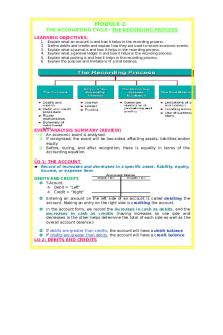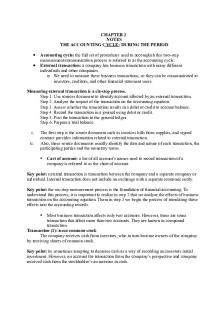2. The Accounting Cycle - the recording process PDF

| Title | 2. The Accounting Cycle - the recording process |
|---|---|
| Course | Accounting Concepts |
| Institution | University of Auckland |
| Pages | 10 |
| File Size | 1.1 MB |
| File Type | |
| Total Downloads | 75 |
| Total Views | 193 |
Summary
Lecturer: Glenn Rechtschaffen
Course taken: 2016
Use these notes and you will have no difficulty understanding Acctg102....
Description
MODULE 2. THE ACCOUNTING CYCLE: THE RECORDING PROCESS LEARNING OBJECTIVES: 1. 2. 3. 4. 5. 6.
Explain what an account is and how it helps in the recording process. Define debits and credits and explain how they are used to record economic events. Explain what a journal is and how it helps in the recording process. Explain what a general ledger is and how it helps in the recording process. Explain what posting is and how it helps in the recording process. Explain the purpose and limitations of a trial balance.
EVENT ANALYSIS SUMMARY (REVIEW) An economic event is analysed. If recognised, the event will be two-sided, affecting assets, liabilities and/or equity. Before, during, and after recognition, there is equality in terms of the accounting equation.
LO 1: THE ACCOUNT Record of increases and decreases in a specific asset, liability, equity, income, or expense item Account Name
DEBITS AND CREDITS T-Acount: Debit = “Left” Credit = “Right”
Debit / Dr.
Credit / Cr.
Entering an amount on the left side of an account is called debiting the account. Making an entry on the right side is crediting the account. In the account form, we record the increases in cash as debits , and the decreases in cash as credits (having increases on one side and decreases in the other helps determine the total of each side as well as the overall account balance.) If debits are greater than credits, the account will have a debit balance If credits are greater than debits, the account will have a credit balance
LO 2: DEBITS AND CREDITS
DOUBLE ENTRY SYSTEM Each recordable event affects at least two accounts. The increase or decrease to an account is recorded with a debit or a credit, depending on the account. For each recordable event, total dollar debits must equal total dollar credits. Rules of double entry bookkeeping Reserves A = L + OE A = L + Share capital (OE) + Income – Expenses – Cash dividends Assets are on the left, so increase them with debits. Liabilities and equity are on the right, so increase them with credits. Equity is increased with share capital and income (including revenues), so increase these accounts with credits. But expenses and cash dividends decrease equity, so increase these accounts with debits. DEBITS AND CREDITS
DR.
DEBITS A+E+D Increase
CREDITS L + C (OE) + R Decrease
CR.
Decrease
Increase
Assets and Liabilities:
Debits Increase assets
Credits Decrease assets
to a specific Debits Decrease liabilities Increase in liabilities asset account should exceed the credits to that account. Credits to a liability account should exceed debits to that account The normal balance of an account is on the side where an increase in the account is recorded
Equity:
Revenues and expenses:
Debits Decreases revenues
Credits Increase revenues
Increase expenses
Decrease expenses
LO 3: JOURNALISING THE JOURNAL Business documents, such as an invoice, a cheque, or a cash register tape, provide evidence of a recordable event. Journal = book of original entry. Journal acts as a check to check back whether credits and debits are equal to each other Events are recorded in the journal in chronological order. Journal’s contributions to the recording process: It discloses in one place the complete effects of an event/ transaction. Provides a chronological record (of transactions). Helps to prevent or locate errors because the debit and credit amounts can be easily compared. Journalizing Entering transaction data in the journal is know as journalizing Companies make separate journal entries for each transaction A complete entry consists of: The date of the transaction The accounts and amounts to be debited and credited
A brief explanation of the transaction For each part of a recordable event, first determine the appropriate account affected (conceptual framework/residual analysis), then apply the rules of debit and credit: 1. The ____ account has increased/decreased, which increased/decreased A,L, or OE. 2. An increase/decrease to A,L, or OE is recorded with a DR/CR. 3. Therefore, DR/CR the ____ account.
LO 4: THE LEDGER GENERAL LEDGER The entire group of accounts maintained by a company is the ledger The ledger keeps in one place all the information about changes in specific account balances A general ledger contains all the asset, liability and equity/expense accounts
Chart of Accounts This chart lists the accounts and the account numbers that identify their location in the ledger. The numbering system that identifies the accounts usually starts with the statement of financial position accounts and follows with the income statement accounts.
Standard Form of Account T-account form used in accounting textbooks Ledger form used in practice
LO 5: POSTING POSTING Posting: the process of transferring amounts from the journal to the ledger accounts. Posting involves the following steps: In the ledger, enter, in the appropriate columns of the account(s) debited, the date, journal page, and debit amount shown in the journal. In the reference column of the journal, write the account number to which the debit amount was posted. In the ledger, enter, in the appropriate columns of the account(s) credited, the date, journal page, and credit amount shown in the journal. In the reference column of the journal, write the account number to which the credit amount was posted.
THE RECORDING PROCESS ILLUSTRATED The purpose of transaction analysis is first to identify the type of account involved, and then to determine whether to make a debit or a credit to the account. Follow these steps: a. Determine what type of account is involved. b. Determine what items increased or decreased and by how much. c. Translate the increases and decreases into debits and credits. Investment of cash by shareholders
Purchase of office equipment
Receipt of cash for future service
Payment of monthly rent
Payment of insurance
Purchase of supplies on credit
Declaration and payment of dividend
Payment of salaries
Receipt of cash for services provided
LO 6: THE TRIAL BALANCE TRIAL BALANCE Trial balance = a list of accounts and their balances at a given time The primary purpose of a trial balance is to prove (check) that the debit equal the credits after posting
The sum of the debit balances in the trial balance should equal the sum of the credit balances – if the debits and credits do not agree, the company can use the trial balance to uncover errors in journalising and posting. The trial balance is useful in preparing financial statements The steps for preparing a trial balance are: 1. List the account titles and their balances 2. Total the debit and credit columns 3. Prove the equality of the two columns
LIMITATIONS OF TRIAL BALANCE The trial balance may balance even when: An event is not journalized, A correct journal entry is not posted, A journal entry is posted twice, Incorrect accounts are used in journalizing or posting, or Offsetting errors are made in recording the amount of a transaction. The trial balance does not prove that the company has recorded all transactions or that the ledger is correct...
Similar Free PDFs

Completing the Accounting Cycle
- 152 Pages

Ch04 Completing the Accounting Cycle
- 73 Pages

Process Recording #1 copy
- 4 Pages

Process Recording Assignment
- 6 Pages

Process Recording Assignment
- 7 Pages

Field 4 - Process Recording
- 6 Pages

Process Recording Supplement
- 5 Pages
Popular Institutions
- Tinajero National High School - Annex
- Politeknik Caltex Riau
- Yokohama City University
- SGT University
- University of Al-Qadisiyah
- Divine Word College of Vigan
- Techniek College Rotterdam
- Universidade de Santiago
- Universiti Teknologi MARA Cawangan Johor Kampus Pasir Gudang
- Poltekkes Kemenkes Yogyakarta
- Baguio City National High School
- Colegio san marcos
- preparatoria uno
- Centro de Bachillerato Tecnológico Industrial y de Servicios No. 107
- Dalian Maritime University
- Quang Trung Secondary School
- Colegio Tecnológico en Informática
- Corporación Regional de Educación Superior
- Grupo CEDVA
- Dar Al Uloom University
- Centro de Estudios Preuniversitarios de la Universidad Nacional de Ingeniería
- 上智大学
- Aakash International School, Nuna Majara
- San Felipe Neri Catholic School
- Kang Chiao International School - New Taipei City
- Misamis Occidental National High School
- Institución Educativa Escuela Normal Juan Ladrilleros
- Kolehiyo ng Pantukan
- Batanes State College
- Instituto Continental
- Sekolah Menengah Kejuruan Kesehatan Kaltara (Tarakan)
- Colegio de La Inmaculada Concepcion - Cebu








